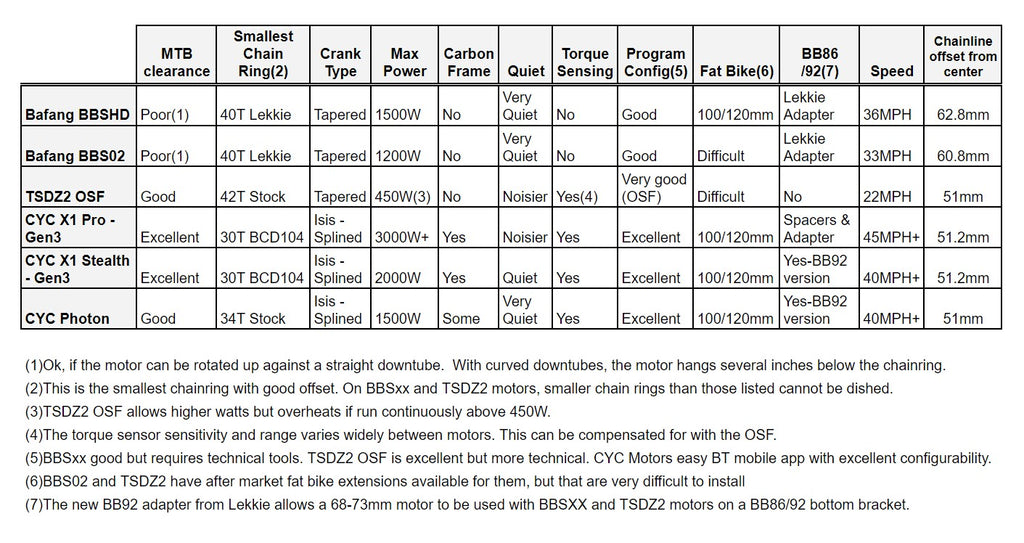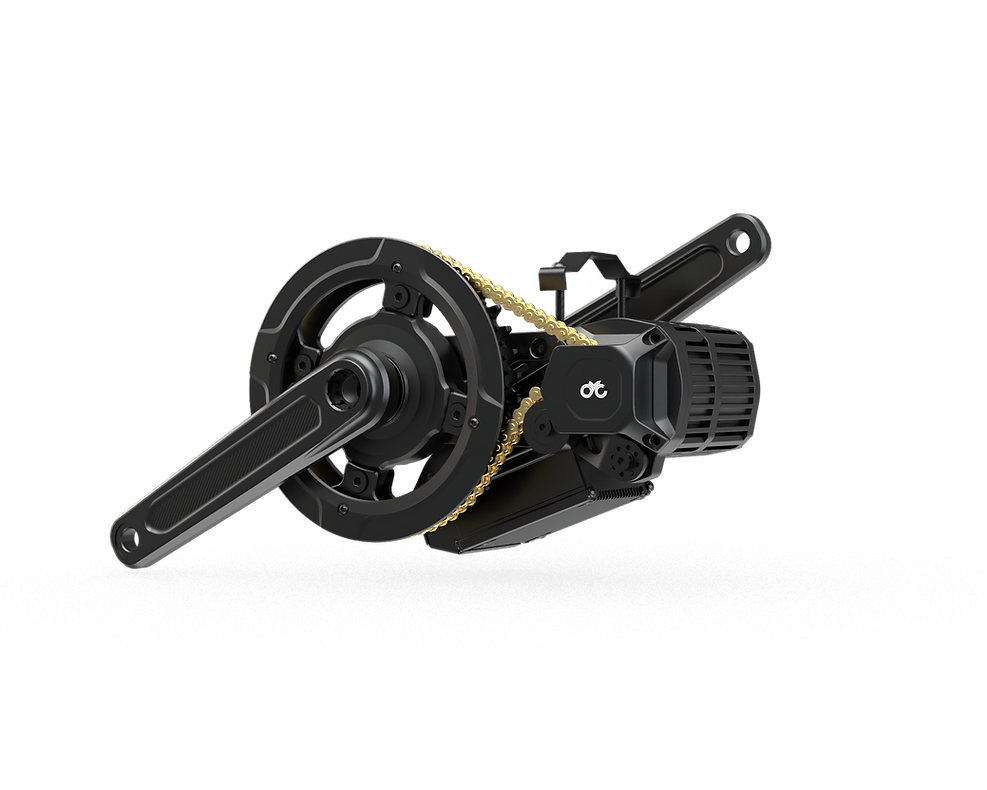
CHOOSING A DIY CONVERSION MID-DRIVE MOTOR
Compares the most popular mid-drive motors for DIY conversions including: BBSHD, BBS02, M625, TSDZ2, CYC X1 Pro Gen 3, CYC X1 Stealth Gen 3
 www.electrifybike.com
www.electrifybike.com
CHOOSING A DIY CONVERSION MID-DRIVE MOTOR
This article will focus on the six popular mid-drive motor kits used for ebike conversions. They are popular because they are all excellent motor kits. Each has its advantages. Check out the chart at the end of the article for a comparison of the key points of each.TABLE OF CONTENTS
- Advantages of mid-drive motors
- Bafang Mid-drive Motor Conversion Kits
- Bafang BBS02
- Bafang BBSHD
- Bafang Mid-drive Motor Issues
- BBS02 vs. BBSHD Summary
- Bafang M625
- Bafang mid-drives vs. TSDZ2
- Advantages of the TSDZ2 over the BBS02
- Advantages of Bafang mid-drives over the TSDZ2
- CYC Motor Mid-drive Conversion Motors
- CYC Photon
- CYC X1 Pro
- CYC X1 Stealth
- CYC X1 Pro vs.CYC X1 Stealth Summary
- CYC vs. Bafang
- CYC vs. TSDZ2
- DIY Mid-drive Motor Feature Comparison Chart
MID-DRIVE MOTORS VS. HUB MOTORS
Mid-drive motors are found on higher-end ebikes and come with distinct advantages over hub motors. There are five primary reasons to choose a mid-drive motor for your ebike conversion.- Center of Gravity: Low and centered for a balanced central motor placement
- Easier Maintenance: Replace flat rear tires hassle-free with no motor in the wheel, just like a regular bicycle.
- Motor Efficiency: Able to be appropriately geared for speed and hills
- Torque Performance: Geared for uphill terrain and riding into the wind
- Longer Battery Life: Doesn’t bog down from being geared too high
BAFANG MID-DRIVE MOTOR CONVERSION KITS
The BBSHD and the BBS02 comprise the Bafang powerhouse family of mid-drive motors. Between these two, nearly every bottom bracket for bikes is covered from 68 to 120mm. From comfort cruisers to colossal fat bikes, Bafang mid-drive motors will bring a smile to any rider. Tackle any hill or mountain. Heck, you can even climb stairs.Bafang mid-drive motor kits are some of the most popular motors on the planet for DIY ebike conversions and with good reason. They are solid, reliable, powerful, and the quietest mid-drive motors we have found. They are quieter than geared hub motors and the big brand mid-drive motors like Bosch, Yamaha, and Brose. And are almost as silent as direct-drive hub motors. If silent running and power are high on your list, then Bafang mid-drive motor kits are a clear winner.
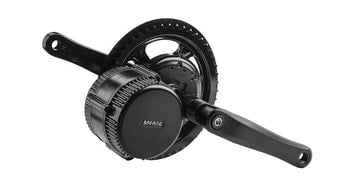
Bafang BBS02 750W | 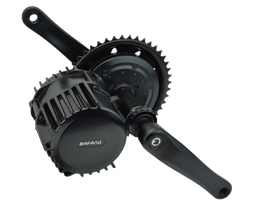
Bafang BBSHD 1000W |
BAFANG BBS02
Bafang makes the BBS01/02 motor in a 250-watt, 350-watt, and 500-watt mid-drive configuration, but at Electrify Bike Co., we only carry the BBS02 750-watt. Why is that? The 250-watt and 350-watt motors are primarily for countries with e-bike laws limiting the maximum watts to those wattages. In the USA, the e-bike watt limit is 750 watts, so the Bafang BBS02 kit is perfect. For some bikes, customers, and riding conditions where less power is desirable, the 500-watt motor makes more sense. But the 500-watt motor is the same price as the 750-watt motor, and we can configure the 750-watt motor to be a 500-watt motor when needed. A 750-watt motor can become a 500-watt motor when 750 watts is too powerful for the bike or the rider. A 750-watt motor will also last longer when run at the lower wattage.The BBS02 only comes in a single bottom bracket size. It fits threaded bottom brackets that are 68mm and 73mm wide. If you have a press-fit bottom bracket of this width, we have adapters that can convert your bottom bracket to the threaded standard so the BBS02 can fit. With the new Lekkie adapter, you can also install it on BB86/92. If you have a wider 100mm or 120mm fat bike bottom bracket, you need to use either the Bafang BBSHD or CYC X1 Pro, or X1 Stealth.
The BBS02 is our go-to Bafang mid-drive kit for most bikes and customers. Quiet and powerful, the BBS02 cranks out 120Nm of torque. Compare that to most high-end factory e-bikes with mid-drive motors having torques topping out at 65Nm to 80Nm. It is affordable and fits almost all older bikes and newer bikes that don’t have a wider bottom bracket. It can now fit BB86 and BB92 bottom brackets with the introduction of Lekkie’s new BB86/92 adapter for BBSxx.
BAFANG BBSHD
The BBSHD is a 1000-watt beast of a motor. It is about 3.5lbs heavier than the BBS02 and delivers a peak power of over 1500 watts. Although weighing in at about 13lbs, this motor is super silent and has a massive torque of 160Nm. There are small cars with the same amount of torque.Given its full power range, this motor is strictly for off-road use where motorized vehicles are allowed. However, it can be programmed to be street and bike trail legal if you want to use it everywhere because you like this motor’s ruggedness and reliability. For those that want street-legal and full power, we also sell a unique display, the Eggrider V2, that can reprogram the motor on the fly for a street-legal, power-limited mode and an off-rode, full-power mode depending on where you are riding.
In addition to the 68/73mm bottom bracket sizes that the BBS02 fits, the BBSHD also comes in 100mm and 120mm BB widths. These are typically used exclusively on fat bikes. The BBSHD is always an excellent choice for a fat bike because they are heavier and often used in sand, snow, or steep terrain. However, The 100mm also bridges the gap to 83-92mm bottom brackets. These are popular BB widths for high-end mountain bikes. To fit the BBSHD, these typically require press-fit adapters and 8-16mm of bottom bracket spacers, and these conversions are solid. When possible, the spacers should go on the non-drive side to help equalize the Q-factor. Exceptions are when some spacing is necessary on the drive side so that the “gear reduction housing” clears the right chain stay. As with the BBS02, with the new Lekkie adapter, you can install the 68mm version of the BBSHD on BB86/92.
BAFANG MID-DRIVE MOTOR ISSUES
The BBS02 and BBSHD are tried and proven but older designs. Their single-piece construction has simplified DIY conversions but has some limitations for modern high-end bikes. Most newer mountain bikes have a downtube that extends out from the bottom bracket nearly horizontally before curving up to the headtube. Bafang designed the BBS motors 6 to 8 years ago when almost all bikes’ downtube came straight down from the head-tube to the bottom bracket without curving horizontally. This geometry allowed the motor to rotate up against the downtube when installing it to get good ground clearance. When you put a Bafang BBS mid-drive motor on a newer, more modern mountain bike, it can’t rotate up, and as a result, it hangs down with less than optimal ground clearance and less than optimal appearance. CYC Motors designed the new CYC X1 Pro and CYC X1 Stealth to eliminate this problem and to have excellent ground clearance and a sleek appearance on all frame types.Carbon frames often cannot accommodate a Bafang mid-drive motor because the bottom bracket shell casing is too thick. Bafang mid-drive motors have a 12mm clearance between the motor housing and the spindle. Most carbon frames have a BB shell casing thicker than this, and the motor won’t slide into the bottom bracket. The newer CYC X1 Pro and X1 Stealth design eliminates this problem.
Bafang mid-drive motors are cadence only, meaning that the motor knows when and how fast you are pedaling. But it doesn’t know how hard you are pedaling. It has 24 magnets to detect cadence, but it doesn’t have a torque sensor to detect your effort. The TSDZ2, X1 Pro, X1 Stealth, and Photon mid-drives have torque sensors.
Many Bafang users complain that it is more like a motorcycle than a bike. It’s no wonder they say this because Bafang configures these motors at the factory to have about 50% power in assist level one. That is attenuated by the speed % also set to 50%, but that is still crazy. When you start pedaling in level one, you have over 200 watts on a BBS02 and over 300 watts on a BBSHD. That is close to the same power factory e-bikes have on their highest level of assistance, typically 250-350 watts. The Electrify Bike Co. secret sauce for Bafang includes programming each motor we sell to start at around 100 watts and then increase linearly with each assist level to full power at the highest level. This way, the Bafang mid-drive assists at a low enough level that it still feels natural despite not having a torque sensor. A low level of assistance makes it feel like a bike, not a motorcycle. It extends battery range and lets you get as much exercise as you want.
Lastly, the all-in-one mid-drive motor design that Bafang has a patent on has a flaw that plagues every install to some degree. Some bikes hardly notice while others have difficulty shifting into the lower gears. The issue is the chain line. Because the gear reduction housing sits between the bottom bracket and the chainring, it pushes the chainring outboard ~20mm. Bafang compensated for this by providing a dished chainring that is 46T. This is ok for commuter and cruiser bikes but is too high of a gear for MTBs. Lekkie, a New Zealand company, came to the rescue with two dished chainrings that are 42T and 40T. If you want to go smaller, Lekkie makes them down to 28T, but they cannot be dished because the gear reduction housing is too big, and the smaller gears can’t be dished around it. Many still choose to ride with those lower gears, but they do so at the expense of their chain line. The chain can be very noisy and wear out cogs and chains much quicker.
BBS02 VS. BBSHD SUMMARY
If you have a 68/73mm bottom bracket (or 86/92 press fit with the Lekkie adapter), then the chances are that the BBS02 will be what you want. If you have a fat bike with a 100-120mm bottom bracket or want extra power with a smaller bottom bracket, you will need the BBSHD. If you carry lots of weight, have a cargo bike, a heavy cruiser, or just want all the torque you can get for steep terrain, you may also want to lean toward the BBSHD. However, keep in mind that many people underestimate the BBS02 750-watt motor. They convince themselves they need the BBSHD but have never ridden the BBS02 to know just how powerful it is. In our parking lot on flat terrain, we let customers ride bikes with each motor, and they often come back and say they couldn’t tell the difference between the BBS02 and the BBSHD.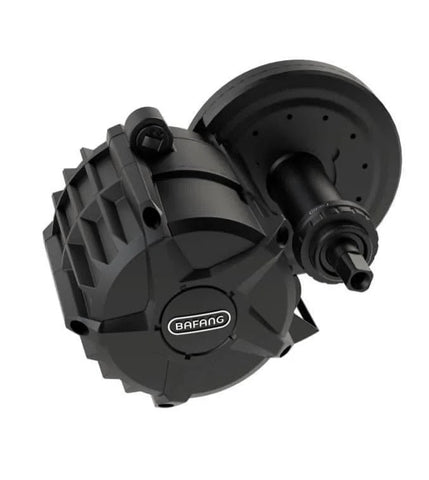
BAFANG M625
The M625 is Bafang’s newest DIY mid-drive motor kit. It is an upgrade to the 1000W BBSHD. There are also 500W and 750W versions introduced as upgrades to the BBS02. Unfortunately, the major upgrades also have a downside, making them less suitable for most DIY conversions and custom ebikes. What are the upgrades that are downgrades? First, they changed their communications protocol to CANbus. CANbus is a peer-to-peer network protocol used in cars to communicate between ECUs and MPUs in various subsystems. That would be good, except Bafang decided they would lock in the factory configuration settings and not allow customers to configure their motor to a different bike, rider, and riding style characteristics. That configuration flexibility is still available with the BBS02 and BBSHD and is a big deal to DIYers. Second, they upgraded to a magnesium case. Magnesium is lighter, which would be good if the motor was lighter. It is not. What it is, is expensive. The M625 is more expensive without offering any substantial improvements. If Bafang had taken the opportunity to improve the chain line and add torque-sensing, the M625 mid-drive motor kit would be a big upgrade and a real contender in the 2022 DIY mid-drive motor space. Instead, they created a huge opportunity for newcomers like CYC Motor LTD.There are a few other minor cosmetic improvements but nothing to overcome the major detractors. The new features above appear to have bigger downsides than upsides. In addition, the M625 inherits all the major deficiencies of the BBS02 and BBSHD. These are bad chain lines due to the gear reduction housing pushing the chainring out, no torque sensing capability, and poor ground clearance.
Another huge problem with the Bafang M625 is that Bafang decided to make the motor only work with a specific battery and charger from Bafang. You must buy the entire motor and battery system from Bafang. Other mid-drive motor manufacturers like Bosch, Yamaha, and Shimano also have proprietary battery and motor combinations. Using CANbus protocol, the motor controller and battery talk to each other to ensure they are both from the same manufacturer before the motor turns on. The battery also talks to the charger to ensure they are both from the manufacturer before charging. This limits choice, upgrades, and the ability to get the right size battery for what you need.
The batteries Bafang designed to be sold with this motor are big and bulky and don’t fit many bike frames. There are almost no full-suspension frames that can fit these batteries. The only option if it won’t fit in the frame is to put a huge heavy battery on a rear rack. When you do this, it throws the balance of the bike off. It is much better to choose a motor that gives a broad choice of third-party and custom batteries to suit the needs of the rider and the bike. The M625 is the only DIY motor in this article requiring a proprietary battery to be used.
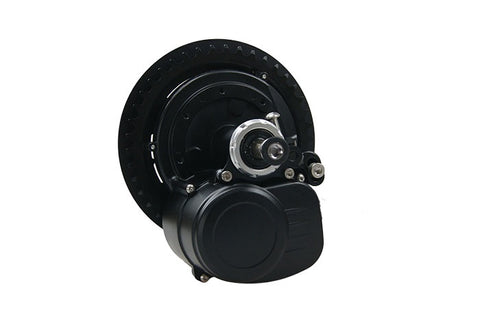
BAFANG MID-DRIVES VS. TSDZ2
Ok, let’s cut to the chase on this one right up front. Both the BBS02 and the TSDZ2 are close together in price, and they are both mid-drive motors. That’s about as far as their similarities go. They each have their place, and choosing one over the other simply matters what features you value the most.ADVANTAGES OF THE TSDZ2 OVER THE BBS02
Those drawn to the TSDZ2 usually come to it by searching “torque sensing mid-drive motor.” Until the CYC line of mid-drive motors came out, the TSDZ2 was the only game in town for torque sensing, which is its primary advantage over the Bafang mid-drive motors. With torque-sensing, the motor not only senses that you are pedaling but also senses how hard you are pedaling and can respond accordingly. It can feel very natural to have the ebike respond by magnifying your effort with motor power and not just put out a constant amount of power whenever you are pedaling as the Bafang motors do,The TSDZ2 is also lighter than the BBS02. If you are trying to respect a lightweight bike and keep your electric conversion’s weight to a minimum, the TSDZ2 will help.
The TSDZ2 also comes in a coaster brake version. If you have a coaster brake bike, this is the only game in town. No other mid-drive or rear hub motors can work with a coaster brake. You could put a front hub motor on a coaster brake bike, but front hubs have their own issues. The TSDZ2 coaster brake motor opens up a lot of fun bikes to the possibility of an even more fun ebike.
One of the best-kept secrets regarding the TSDZ2 is the Open Source Firmware (OSF). Electrify Bike Co. collaborated with some excellent European engineers to replace the firmware in the TSDZ2 to accommodate many different bikes and riding styles. OSF replaces the factory firmware and extensively customizes how the motor responds. Those that like to fiddle and fine-tune the performance have a vast array of options with this firmware.
OSF performs very well right out of the box. Still, suppose you want to make adjustments like changing the power performance on each level or increasing the torque sensitivity. In that case, OSF gives you many configuration options to make it exactly how you want it.
The latest version of OSF also works well with the coaster brake version of the TSDZ2. It works much better than the stock firmware. As a result, we have decided only to sell the TSDZ2 with OSF. Eliminating the stock firmware streamlines our product offering and allows us to provide consistent support to all of our TSDZ2 customers.
ADVANTAGES OF BAFANG MID-DRIVES OVER THE TSDZ2
Bafang motors are quieter and more powerful than the TSDZ2. Some TSDZ2 motors are more silent than others, but it is the luck of the draw. You don't know beforehand if you will be lucky or not. But even the more silent TSDZ2 motors are not as quiet as the BBS02 or the BBSHD.Comparing the motor components of the BBS02 and the TSDZ2, it is striking how much beefier the BBS02 is. The more substantial BBS02 parts provide more power, better heat dissipation, and reliability, giving it the advantage in robustness.
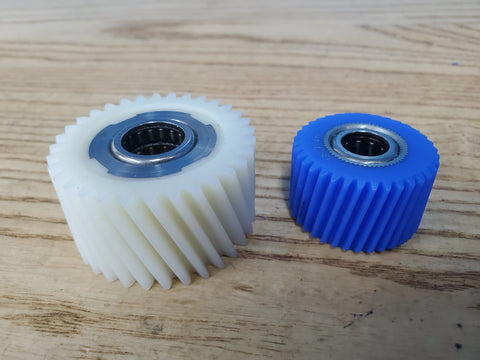
Bafang vs. TSDZ2 plastic gear
Both of these excellent tried, and proven motors have their place. The above discussion should put one or the other ahead on your preference list based on what features you value the most. If you want the natural feel of torque sensing and don’t need lots of power, the TSDZ2 will take the lead. However, if you want lots of power and a robust motor to back it up, the BBS02 is the clear winner. If you value both torque sensing and power, you should take a look at the new CYC X1 Stealth.
CYC MOTOR MID-DRIVE CONVERSION MOTORS
In 2018, CYC Motor Ltd was born; they gathered a talented engineering team and launched a new generation of DIY mid-drive motors with the CYC X1 Pro. Since then, they launched the X1 Pro's baby brother, the X1 Stealth, and now one year later, they have launched the third generation of both motors, with still more amazing products yet to come. CYC Motor Ltd. brings steady improvement and excellent support to the DIY mid-drive motor market. Two critical things ebike conversion DIYers have desperately needed.This next generation of DIY motors from CYC solves many problems inherent in previous mid-drive conversion kits from other manufacturers. With the bottom bracket separate from the motor, it has the fitment flexibility to accommodate over 90% of all bike frames, including carbon frames. Additionally, unlike other mid-drive motors, the chainring is on the inside of the gear reduction gears, allowing you to have a perfect chain line without the typical offset you'd find on similar motors.
The real difference with CYC motors comes from its industry-leading controller technology and torque sensing capability, The natural feel coupled with extreme power is unprecedented. The CYC engineering team found the sweet spot between natural riding and pure power to open a new dimension for DIY mid-drive conversion kits. You have the natural feel of riding a bike, but you can fly up mountains like you have superpowers.
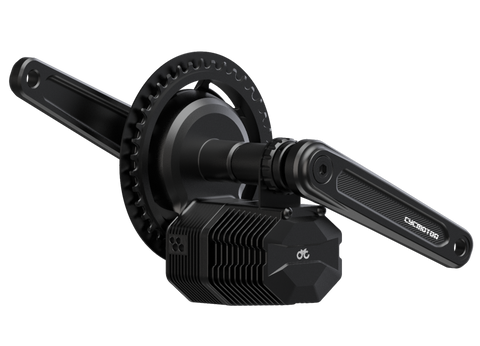
CYC PHOTON
The CYC Photon mid-drive motor is the creation of CYC Motors in Hong Kong. The CYC Photon is the newest entrant into DIY mid-drive motors. The Photon sets the bar higher than it has ever been for DIY mid-drive motors. It has a finely tuned response to meet the demands of the most discriminating cyclist or MTBer. On top of that, it sets a new precedent for power and quietness in a lightweight motor kit.This motor preserves a perfect chain line on any bike down to a 34T chainring and has great ground clearance. With its torque sensing and cadence sensing bottom bracket, it delivers power at the cadence you choose and senses when you crank up your effort and delivers more power on demand.
This versatile motor fits most frame types, including fat bikes and some carbon frames. It can be set up as a class 1, class 2, or class 3 ebike from 250 to 750 watts. Off-road modes go from 750 to over 1,000 watts.
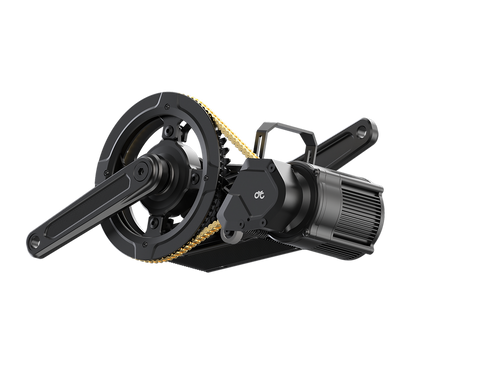
CYC X1 PRO
The CYC X1 Pro is the original powerhouse motor now in its third generation. CYC struggled with some issues early on but listened to users and steadily improved it. The newly launched Gen 3 is the culmination of several years of engineering and dozens of improvements. Now that CYC has developed its own controller, the X1 Pro has smooth power delivery and performance that responds naturally to human effort.The new X6 controller can deliver up to 3000 watts of power, more than most riders need, and requires a reasonably high-powered battery to achieve it. Our 52v 50A Shark batteries and 52v 50A Mini-max battery can deliver 2600 watts and are an excellent match for this motor/controller combination.
Very soon, CYC will release the X12 controller for the X1 Pro, increasing the power to 5000 watts. To give you an idea of the battery required for that much power, you would need a 100 amp 52-volt battery or a 70 amp 72-volt battery to achieve 5000 watts. Those batteries will be huge if you also want some range. For 5000 watts, we only have one 72v 80A 12AH battery, which is limited in range unless you are not pulling near that many watts. At 864 watt-hours, it is still has a respectable capacity as ebike batteries go, but if you pull 5000 watts continuously, it will completely drain in less than 10 minutes. Best to ride it like a sports car and use that power sparingly for bursts of speed when you need it.
Please read this Gen 3 Feature Summary for details on the new X1 Pro Gen 3 upgrades.
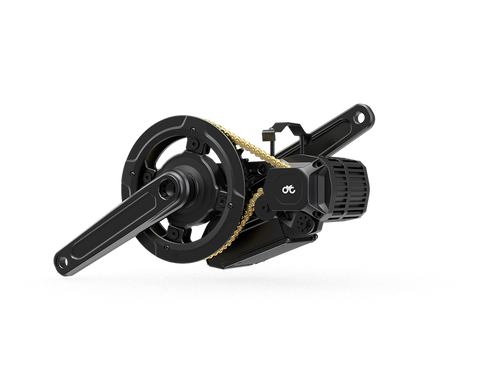
CYC X1 STEALTH
CYC Motor Ltd. wanted a motor that could fill the need for a less powerful DIY motor that still had all of the architectural and performance benefits of the X1 Pro. Hence, they brought out the X1 Stealth. Where the Pro is an in-runner brushless motor, the Stealth is an outrunner brushless motor. Outrunner motor designs allow for maximum torque in a smaller package. Although less powerful than the Pro, the Stealth can still deliver up to 1500 watts of power and 120Nm of torque. That puts it right between the BBS02 and BBSHD for raw power. Add torque sensing and the X6 VESC controller, and you have an all-new, game-changing entry into the DIY mid-drive motor space.Please read this Gen 3 Feature Summary for details on the new X1 Stealth Gen 3 upgrades.
CYC X1 PRO VS.CYC X1 STEALTH SUMMARY
These two motors are part of the same family. Just like the Bafang BBSHD is the big brother of the BBS02, the X1 Pro is the big brother of the X1 Stealth. Between these two motors it all comes down to power, a little bit of weight, and the bottom brackets they will fit. The Pro can bridge from 68/73mm BB regular bikes to 100/120mm BB fat bikes. The Stealth can do regular 68/73mm BB and has a special version for BB86/92 bottom brackets.CYC VS. BAFANG
- Power. The CYC X1 Pro/X6 is more powerful than the stock BBSHD. However, there are mods and more powerful third-party controllers for the BBSHD that can increase its power substantially. These can be pretty pricey and void the warranty. The CYC X1 Pro/X12 will be in motorcycle territory for power but still provide a torque-sensing bike experience.
- Fitment. With only 12mm of clearance between the spindle and the gear reduction/motor housing on the BBSHD, it will not fit on carbon frames that are often wider than 15mm at the bottom bracket. Bottom bracket clearance is not an issue on the CYC X1 Pro. In fact, by relocating the controller, it can often be rotated up into the triangle on a lot of bikes.
- Noise. Although each generation of the X1 Pro and Stealth has become more and more quiet, the BBSHD and BBS02 are still substantially quieter. Kudos to Bafang for building such quiet motors.
- Torque-sensing. Once again, the coup de grace for CYC is in the torque sensing and smooth power delivery of the X-series controllers. With Bafang, pedal assist feels like a power switch that is on when pedaling and off when not pedaling. CYC has all of the nuances of how hard you are pedaling. In addition to knowing that you are pedaling, CYC factors into its pedal assist algorithm how much effort is being applied throughout the pedal stroke and magnifies the power accordingly.
- Chain line. Bafang has the chainring outside the gear-reduction, pushing out the chain line. CYC has the chainring inside the gear reduction and has a chain line near the factory original.
- Ground clearance. CYC has better clearance, especially on bikes with curved downtubes where Bafang mid-drives are forced to hang straight down. With CYC, you can move the controller and snug the motor against the downtube. The motor can even rotate inside the triangle when the geometry allows.
CYC VS. TSDZ2
Before CYC, if you wanted a torque-sensing mid-drive motor, the TSDZ2 was the only option. Although it is a great little motor for the price, due to design shortcuts, the TSDZ2 has a wide variance in things like noise and torque sensitivity. There is a wide variance between motors in the voltage range for the torque sensor and its response curve. OSF can address these issues, but it can require some tedious configuration.Besides reliability and build quality, the obvious differences between CYC and TSDZ2 are in power and price. You must run the TSDZ2 below 500W, or it will overheat. It is a much smaller motor.
DIY MID-DRIVE MOTOR FEATURE COMPARISON CHART
